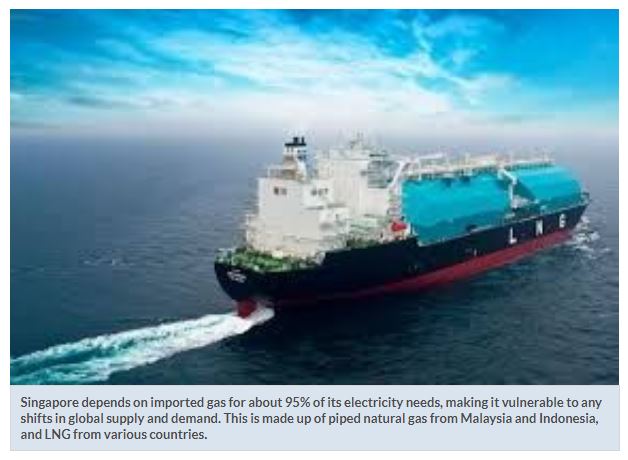Singapore unlikely to face energy price surge amid global demand
SINGAPORE: The republic is unlikely to experience a surge in energy prices despite greater demand for heating and electricity amid an unusually cold winter in the Northern Hemisphere, industry analysts say.
This comes as a rare triple-dip La Nina is forecast to induce below-freezing temperatures in China, Japan and South Korea over the next few weeks and an Arctic blast has dumped snow on Britain and Germany.
The chill has triggered fears of further gains in Asian liquefied natural gas (LNG) prices, which have been increasing since the middle of November after plunging from a peak in late August.
Singapore depends on imported gas for about 95% of its electricity needs, making it vulnerable to any shifts in global supply and demand. This is made up of piped natural gas from Malaysia and Indonesia, and LNG from various countries.
Chong Zhi Xin, director for gas, power and climate solutions at S&P Global Commodity Insights, said that while the winter chill is likely to push up gas demand in the Northern Hemisphere, markets around the world are better prepared with storage in 2022.
This should place less stress on the LNG value chain, he said.
Deven Chhaya, infrastructure advisory partner at KPMG Singapore, said that demand for LNG is unlikely to swing significantly if current weather predictions hold, given that most models for power loads and LNG futures contracts would have accounted for lower-than-normal temperatures.
LNG constitutes between 10% and 25% of the energy mix of China, Japan and South Korea, he added.
A spokesman for independent energy research and business intelligence company Rystad Energy noted that while the initial mild start to winter has ended, North-east Asian buyers should still have comfortable levels of inventories, barring any outages on alternative fuels or LNG production, as they had planned for a severe winter.
He said: “Given that South-East Asia’s gas demand is skewed towards power generation in the summer, the northern winter is less of a concern for South-East Asia.
“Contractual deliveries will continue, but at current spot prices approaching US$40 (RM177) per million British thermal units, the region is priced out of the spot market.”
Chong said that tightness in the global spot LNG market will still have a larger impact on Thailand and Singapore, as both markets are more reliant on international supply.
“While we do expect spot LNG prices to increase over the next few months, the impact on Singapore could be minimal.
“The price spike last year was a confluence of factors, including the oil price run-up, markets coming out of Covid-19 and the outage of piped gas supply from Indonesia,“ he said.
This year, the Energy Market Authority has made preparations, including allowing power generation companies to draw on a standby LNG facility, he added.
Deven said Singapore’s power generation has remained relatively stable, albeit with much higher input costs, as supplies have been secured in the short term and higher prices have been factored in.
While colder-than-normal conditions have hit Europe a few times in the past decade, global gas supplies have been strained as European nations deal with the significant loss of gas flows from Russia.
“South-East Asian spot markets may see a spike if a large portion of LNG from the United States is diverted to Europe to meet its replacement demand.
“This is especially given that many European countries have limited options aside from buying from buoyant spot markets,” said Deven. — The Straits Times/ANN


 Thailand
Thailand




